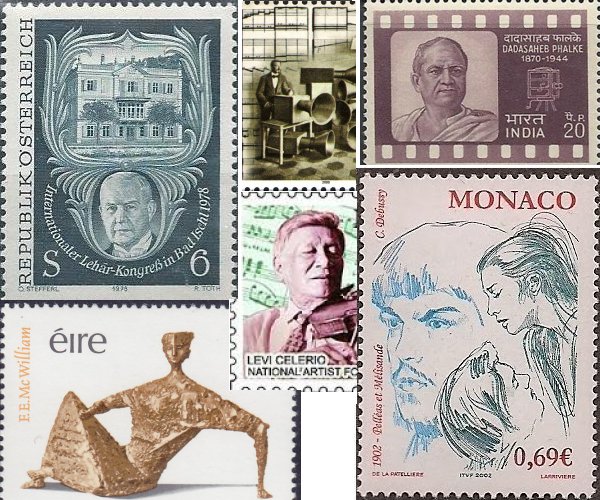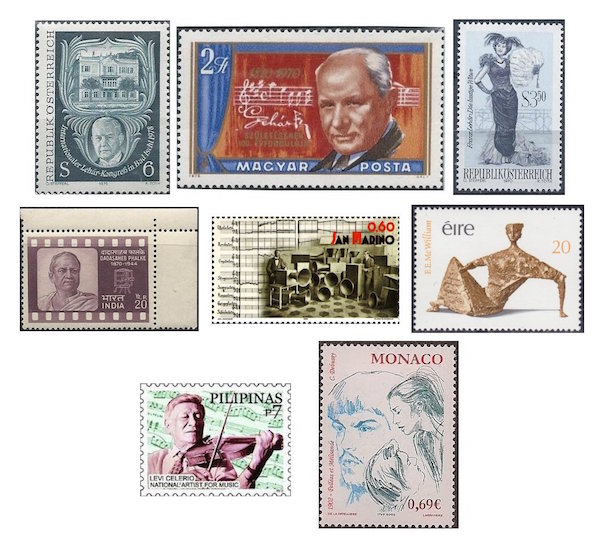The Arts on the Stamps of the World — April 30
An Arts Fuse regular feature: the arts on stamps of the world.

By Doug Briscoe
Yesterday was the birthday of operetta composer Carl Millöcker, and today we honor one of the most famous proponents of that genre, Franz Lehár (30 April 1870 – 24 October 1948). His most celebrated score is The Merry Widow (1905), which has been made into at least five movies and a ballet.
Indian filmmaker Dadasaheb Phalke (30 April 1870 – 16 February 1944) is hailed as the Father of Indian cinema. After all, he made India’s first full-length feature, Raja Harishchandra, in 1912 (first shown in 1913). Within the next two decades he had made a further 95 movies and 26 shorts. Dhundiraj Govind Phalke was born in Maharashtra (incidentally, tomorrow is Maharashtra Day, celebrating the formation of the state in 1960). Phalke studied the visual arts: not just painting and drawing but also sculpture and—tellingly—photography. Indeed his first employment was as a photographer. After the loss of his first wife and child to the plague, he turned to lithography and worked for an artist we celebrated here just yesterday, Raja Ravi Varma, who, you may recall, had opened a printing press operation in 1894. Phalke started his own press but gave it up after a disagreement with his partners. At last he found his forte and thrived in it for twenty years. It was the advent of the talkies that sounded the professional death knell for Phalke. The stamp for him came out in 1971.
Next is a stamp for Luigi Russolo (30 April 1885 – 6 February 1947), an ultramodernist painter, composer, and musical instrument inventor described by Wikipedia as “perhaps the first noise artist.” In 1913 he wrote a manifesto expressing his belief that “the industrial revolution had given modern men a greater capacity to appreciate more complex sounds.” So he went on to construct a collection of instruments he called “Intonarumori” (as seen on the stamp), and then, of course, he had to write something for them. And then in 1917 he gave a performance in what he called a “Gran Concerto Futuristico“. This “was met with strong disapproval and violence from the audience,” which came as no surprise to Russolo. All the devices he constructed have been lost (aw, gee), but don’t despair! Russolo’s brother made a couple of recordings of them in 1921.

Northern Irish sculptor F. E. (Frederick Edward) McWilliam (30 April 1909 – 13 May 1992) came from Banbridge, the son of a doctor. He was a student at the Slade School of Fine Art in London, where he later became a teacher. During World War II he served in the RAF interpreting aerial reconnaissance photographs. McWilliam was honored with a C.B.E. in 1966 and had a major retrospective exhibition at the Tate in 1989. The stamp, which came out in 1979, offers his bronze Seated Woman II of 1961.
Unimaginably prolific Filipino musician Levi Celerio (April 30, 1910 – April 2, 2002) composed and/or wrote the lyrics for more than 4,000 songs! He studied on a scholarship at the Academy of Music in Manila and was the youngest player (violinist) with the Manila Symphony Orchestra. His love songs and Christmas songs are beloved in the Philippines. He was also famous for playing music on a leaf. See for yourself! Celerio received a stamp in 2010.
Today is also the 115th anniversary of the first performance of Debussy’s only opera Pelléas et Mélisande. It was given under André Messager on 30 April 1902 at the Paris Opéra-Comique with Jean Périer and Mary Garden in the title roles.
A graduate of the University of Massachusetts with a B.A. in English, Doug Briscoe worked in Boston classical music radio, at WCRB, WGBH, and WBUR, for about 25 years, beginning in 1977. He has the curious distinction of having succeeded Robert J. Lurtsema twice, first as host of WGBH’s weekday morning classical music program in 1993, then as host of the weekend program when Robert J.’s health failed in 2000. Doug also wrote liner notes for several of the late Gunther Schuller’s GM Recordings releases as well as program notes for the Boston Classical Orchestra. For the past few years he’s been posting a Facebook “blog” of classical music on stamps of the world, which has now been expanded to encompass all the arts for The Arts Fuse.
